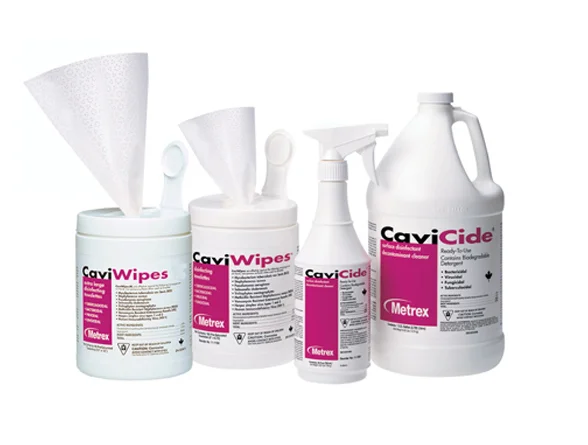When choosing a dental or medical office, one of your main concerns is likely sterilization. This very understandable, with the news full of alarming stories and statistics on secondary infections, pathogens and contaminated surfaces found in medical settings. In light of this, Thousand Oaks Family Dentistry is here to show you the basics of our sterilization and disinfection methods, and why we feel they are the best way to keep our patients safe and healthy.
Cavicide comes in wipes and sprays to adapt to a variety of needs.
When entering one of our operatories, you will notice bags, films and coverings over all commonly used surfaces. These disposable barriers ensure that there is no cross contamination between patients: as soon as one procedure is finished, every covering is replaced. Naturally, some surfaces cannot be covered or protected or might become inadvertently contaminated during a procedure. To maintain the cleanliness of these areas, we use a medical grade disinfectant called Cavicide. This incredible solution is strong enough to kill TB, Hepatitis B, HIV and even MRSA, while remaining gentle enough to be approved for use in NICUs. It is a disinfection standard in hospitals, medical offices and dental practices nationwide and we are proud to offer it as a protective measure for our patients.
Beyond our operatories, we take great care in the cleanliness and maintenance of our instruments. All of our instruments are cleaned and sterilized after every single use- with no exceptions. When possible, we also choose to use disposable products to eliminate any possibility of cross-contamination. We feel that this is the most effective way to maximize patient safety.
An example of an autoclave. Note the secure screw-latch on the left side to withstand high pressure.
In general, our sterilization practice runs in two steps. First, instruments are processed through a medical grade instrument washer under high heat. This process takes about an hour and removes debris and dental materials from any fine surfaces. After washing, instruments are then run again in one of our two autoclaves. Autoclaves work by taking a combination of high heat, steam and pressure to completely sterilize whatever is placed inside them. Scientifically speaking, it would be nearly impossible for any pathogenic (disease causing) entity to actually survive these conditions. Our autoclaves are set to meet or exceed all standards mandated by the state and federal government. In proving their efficacy, we run weekly tests to affirm the machine’s abilities to kill even the toughest bacteria.
These steps apply to roughly 90% of the potentially infectious materials we process at our office. For special instruments and tools, we have a variety of other sterilization methods to keep everything (and everyone) safe. In short, we leave nothing to chance when it comes to sterilization and disinfection. If you have any concerns about our office, how we sterilize or why we use the techniques we use, please let us know. We are proud of how we maintain our facility and it’s cleanliness!




